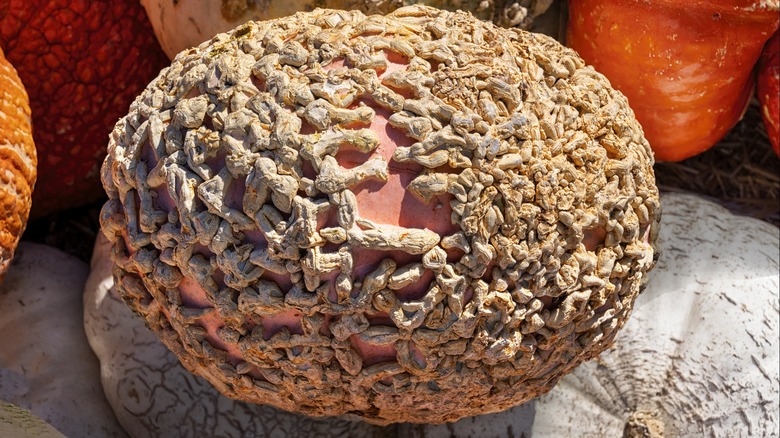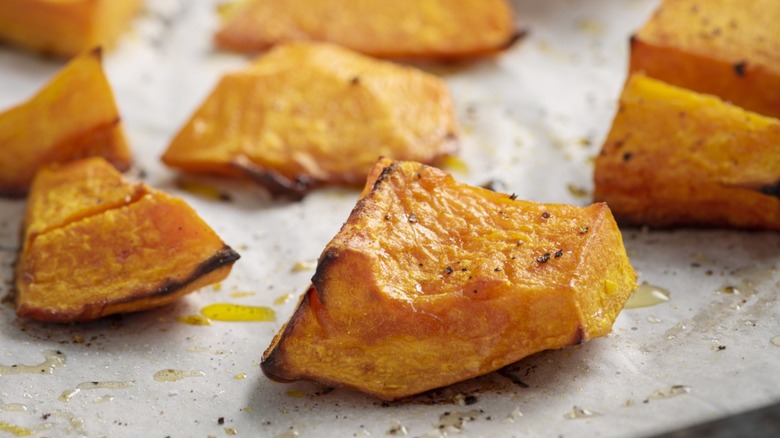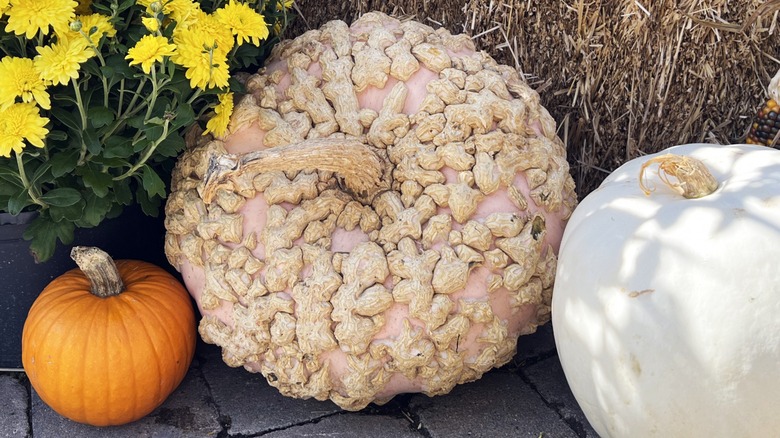Peanut Pumpkins Are The Sweeter Variety You Should Try For Roasting
Named for the peanut-shaped growths that cover their pinkish-orange outer shells, peanut pumpkins are an heirloom variety of squash that offer visual, textural, and flavorful appeal. While they may look strange and creepy, the peanut-shaped nodules that sprout up and spread over the peanut pumpkin's surface are actually a sign of its sweetness.
Just as excess calcium produced by bones leads to bone spurs, the peanut blisters on peanut pumpkins are sugar deposits. So, the more textured, beige blistering you see on a peanut pumpkin, the sweeter its deep orange flesh will be when you cut it open and cook it. Despite its late arrival to the North American pumpkin scene in the mid-'90s, peanut pumpkins come from a centuries-old seed variety harvested in France and named "Brodé Galeux d'Eysines," or "embroidered with scabs from Eysine" in English.
Peanut pumpkins are a large variety, often weighing between 10 and 20 pounds, with ample orange flesh that becomes supple and tender when cooked, offering a rich, sweet flavor described as lying somewhere between sweet potato and apple. Their novel appearance also has decorative value; they'd make a beautifully textured addition to a Thanksgiving spread, and they'd also make a unique substitute for a standard jack-o'-lantern. In fact, you can carve letters or images into their unmarked flesh and blisters will grow into the grooves of the carvings!
Why roast peanut pumpkins?
Peanut pumpkins benefit from most forms of dry cooking, including grilling, sautèing, and baking. Roasting them, however, offers the most depth of flavor and texture. Roasting further caramelizes their sweet flesh and facilitates the infusion of any seasonings and oils you use to coat them. You'll also create a wonderful textural contrast, with crisp, slightly charred edges ceding into a firm yet velvety interior.
Since peanut pumpkins have thick flesh, they won't crater or dry out in the oven. You'll first need to remove the blistered shell with a sharp knife, as only the flesh is used. Then, you can cut them into cubes or crescents, toss them in neutral oil, and season them with baking spices like cinnamon and clove for a spicy and warming complement to their sweetness. They'd also taste delicious as a savory side dish, coated in earthy olive oil and seasoned with salt, rosemary, cracked pepper, and a sprinkle of Parmesan cheese.
If you want to use the flesh in a baked good or soup, you can roast pumpkin halves for a longer period at a lower temperature, keeping their blistered exteriors on. When the flesh is tender, you can scoop it out with a spoon, and add it to soups and batters. As an especially sweet variety, peanut pumpkin pie, bread, or custard would be especially tasty.
Peanut pumpkins vs. conventional pumpkins
Differences between peanut pumpkins and conventional pumpkins are obvious to both the eyes and taste buds. The physical appearance differs greatly between orange, glossy pumpkins and blistered, pink peanut pumpkins. While orange pumpkins can be small or large spheres, peanut pumpkins are on average larger, with flat tops and bottoms.
They have more dense flesh than orange pumpkins, making them especially fruitful for cooking. Furthermore, unlike conventional pumpkins, peanut pumpkins don't have fibrous internal strings, making them much easier to clean and prepare for cooking. Of course, peanut pumpkins are nowhere near as ubiquitous as orange pumpkins, restricted to high-end specialty grocery stores, farmers markets, and home gardens.
Despite all these differences, both pumpkin varieties possess a similar nutritional profile; their orange flesh is rich in beta-carotene, fiber, and vitamins A and C. Plus, you can roast the seeds of both for a tasty, crunchy snack full of antioxidants, healthy fats, and vitamin E. You can also use peanut pumpkin and conventional pumpkins interchangeably in the multitude of pumpkin recipes you use to ring in the fall season, though the peanut pumpkin will impart a noticeable sweetness.


